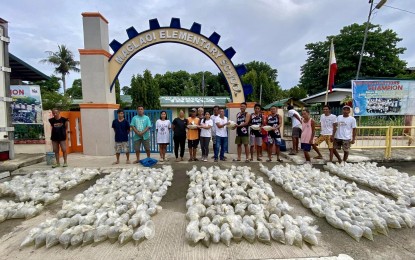
FINGERLINGS DISTRIBUTION. Fish cage operators in Currimao, Ilocos Norte receive bangus fry on Thursday (June 27, 2024). The aid is funded by the Bureau of Fishing and Aquatic Resources-Regional Field Office 1 under its rehabilitation and recovery program. (Photo courtesy of Agriculture Currimao)
LAOAG CITY – The Bureau of Fisheries and Aquatic Resources (BFAR) has distributed thousands of bangus (milkfish) fingerlings to fisherfolk in Ilocos Norte, whose ponds and fish cages were damaged by previous typhoons, to ensure future supplies.
“The distribution of fingerlings is part of our recovery assistance to fishermen affected by calamities before. Overall, we have distributed 45,000 pieces of fingerlings in the city of Laoag and the towns of Pagudpud, Paoay, and Currimao,” Vanessa Abegail Dagdagan, BFAR-Ilocos Norte Senior Aquaculturist, said in an interview Thursday.
During the day, around 10,000 pieces of bangus fry were distributed to Currimao fisherfolk to boost their production.
With this intervention, Dagdagan hopes that the affected fisherfolk will be able to increase their harvest in support of food security and boost fish production in the province after it incurred multi-million damages in fisheries because of previous calamities.
“This is a big help for us. Thank you BFAR for all the help and assistance,” said Mariano Garcia, president of the Barangay Victoria Fisherman’s Association Inc.
In the latest report on fish production by the Philippine Statistics Authority (PSA), Ilocos Region’s overall fisheries production reached 33,173.96 metric tons in the first quarter of 2024, lower by 2.2 percent or 792 metric tons a year ago due to extreme temperatures, high cost of feeds and fuel. (PNA)
